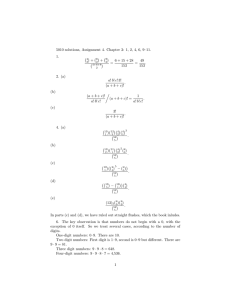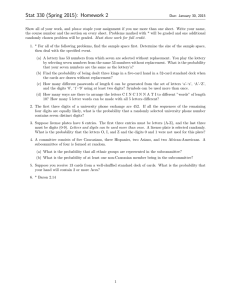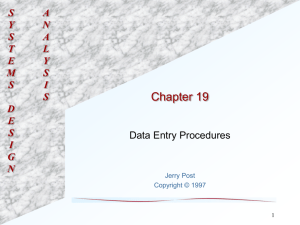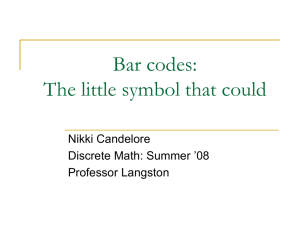Stat 330 (Spring 2015): Homework 2
advertisement
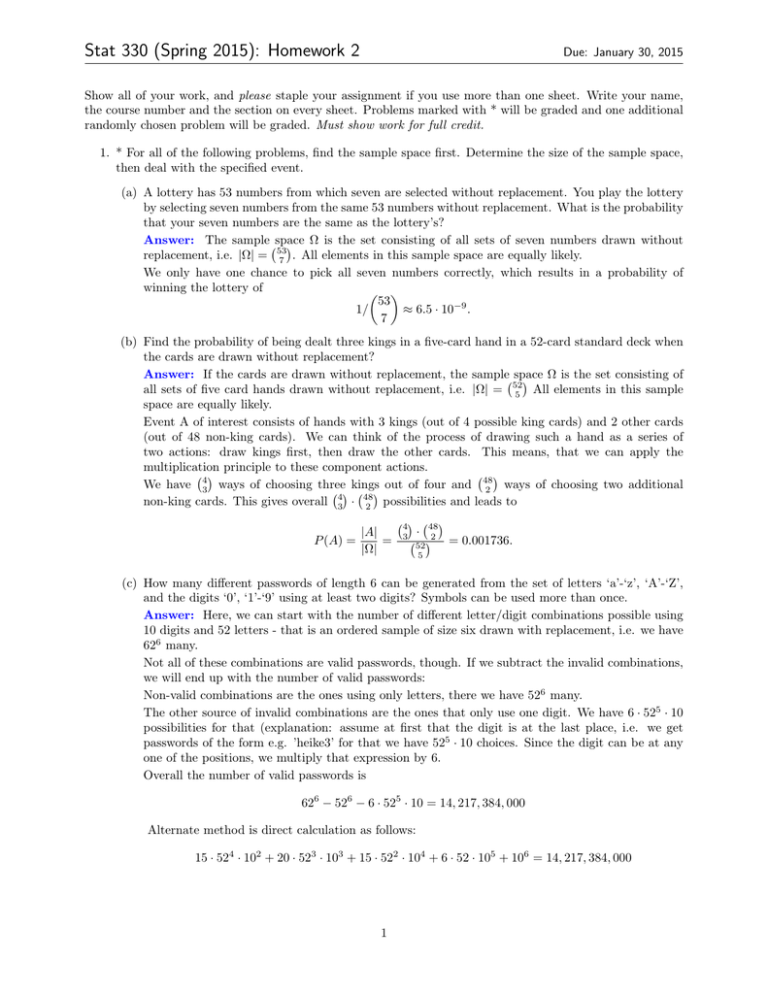
Stat 330 (Spring 2015): Homework 2
Due: January 30, 2015
Show all of your work, and please staple your assignment if you use more than one sheet. Write your name,
the course number and the section on every sheet. Problems marked with * will be graded and one additional
randomly chosen problem will be graded. Must show work for full credit.
1. * For all of the following problems, find the sample space first. Determine the size of the sample space,
then deal with the specified event.
(a) A lottery has 53 numbers from which seven are selected without replacement. You play the lottery
by selecting seven numbers from the same 53 numbers without replacement. What is the probability
that your seven numbers are the same as the lottery’s?
Answer: The sample space
Ω is the set consisting of all sets of seven numbers drawn without
replacement, i.e. |Ω| = 53
7 . All elements in this sample space are equally likely.
We only have one chance to pick all seven numbers correctly, which results in a probability of
winning the lottery of
53
1/
≈ 6.5 · 10−9 .
7
(b) Find the probability of being dealt three kings in a five-card hand in a 52-card standard deck when
the cards are drawn without replacement?
Answer: If the cards are drawn without replacement, the sample space
Ω is the set consisting of
All
elements in this sample
all sets of five card hands drawn without replacement, i.e. |Ω| = 52
5
space are equally likely.
Event A of interest consists of hands with 3 kings (out of 4 possible king cards) and 2 other cards
(out of 48 non-king cards). We can think of the process of drawing such a hand as a series of
two actions: draw kings first, then draw the other cards. This means, that we can apply the
multiplication principle to these component actions.
We have 43 ways of choosing three kings out of four and 48
ways of choosing two additional
2
non-king cards. This gives overall 43 · 48
possibilities
and
leads
to
2
|A|
=
P (A) =
|Ω|
4
3
48
2
·
52
5
= 0.001736.
(c) How many different passwords of length 6 can be generated from the set of letters ‘a’-‘z’, ‘A’-‘Z’,
and the digits ‘0’, ‘1’-‘9’ using at least two digits? Symbols can be used more than once.
Answer: Here, we can start with the number of different letter/digit combinations possible using
10 digits and 52 letters - that is an ordered sample of size six drawn with replacement, i.e. we have
626 many.
Not all of these combinations are valid passwords, though. If we subtract the invalid combinations,
we will end up with the number of valid passwords:
Non-valid combinations are the ones using only letters, there we have 526 many.
The other source of invalid combinations are the ones that only use one digit. We have 6 · 525 · 10
possibilities for that (explanation: assume at first that the digit is at the last place, i.e. we get
passwords of the form e.g. ’heike3’ for that we have 525 · 10 choices. Since the digit can be at any
one of the positions, we multiply that expression by 6.
Overall the number of valid passwords is
626 − 526 − 6 · 525 · 10 = 14, 217, 384, 000
Alternate method is direct calculation as follows:
15 · 524 · 102 + 20 · 523 · 103 + 15 · 522 · 104 + 6 · 52 · 105 + 106 = 14, 217, 384, 000
1
Stat 330 (Spring 2015): Homework 2
Due: January 30, 2015
(d) How many ways are there to arrange the letters C I N C I N N A T I to different ”words” of length
10? How many 5 letter words can be made with all 5 letters different?
Answer: The word has 10 positions to be filled. We have 2 C’s, 3 I’s, 3 N’s, 1T and 1A to form
the word. We can think of doing sequentially, i.e. we have five sub-actions, and use multiplication
rule to determine the total number of possibilities.
• The first action fills 2 positions with C’s, remembering order does not matter.
• Now there are only 8 positions left, second action fills 3 positions with I’s, again order does not
matter.
• Now there are only 5 positions left, third action fills 3 positions with N’s, again order does not
matter.
• Since only two positions remain, we fill them with T and I or I and T, and these are the 2
actions left.
Overall, the number of ways are
10
8
5
2
10!
8!
5!
2!
10!
·
·
·
·1=
·
·
·
=
= 50400
2! · 8! 3! · 5! 3! · 2! 1! · 0!
3!3!2!
2
3
3
1
In the second question, to get a five-letter word with different letters we have to use the 5 letters
C I N A T in the words. Then we sse that we can get P(5,5) or 5!=120 words, becaue in this case
order does matter!
2. The first three digits of a university phone exchange are 452. If all the sequences of the remaining
four digits are equally likely, what is the probability that a randomly selected university phone number
contains seven distinct digits?
Answer:
|Ω| = 104 = 10, 000. Let A = the event that the 4 digits are one of {0, 1, 3, 6, 7, 8, 9}. Then |A| = 7 · 6 · 5 · 4
840
or P (7, 4). Thus the required probability = |A|
|Ω| = 10000 = 0.084.
3. Suppose license plates have 6 entries. The first three entries must be letters (A-Z), and the last three
must be digits (0-9). Letters and digits can be used more than once. A license plate is selected randomly.
What is the probability that the letters O, I, and Z and the digits 0 and 1 were not used for this plate?
Answer:
The number of all possible plates = |Ω| = (26)3 · (10)3 . The number of plates excluding O, I, Z, 0, 1
(23)3 ·(8)3
3
= |A| = (23)3 · (8)3 . P (plate excludes O, I , Z, 0, 1) = |A|
|Ω| = (26)3 ·(10)3 = (0.8846 · 0.8) = 0.3544.
4. A committee consists of five Caucasians, three Hispanics, two Asians, and two African-Americans. A
subcommittee of four is formed at random.
(a) What is the probability that all ethnic groups are represented in the subcommittee?
(b) What is the probability of at least one non-Caucasian member being in the subcommittee?
Answer:
Total possible subcommittees = |Ω| =
12
4
=
9 · 10 · 11 · 12
= 495.
2·3·4
5 3 2 2
(a) The number of subcommittees representing all ethnic groups = |A| =
= 60 so
1 1 1 1
that P (all ethnic groups represented) = 60/495 = 4/33 = 0.1212
5
(b) P (at least 1 non-Caucasian member) = 1 − P (0 non-Caucasian members) = 1 −
2
4
12
4
= 98/99
Stat 330 (Spring 2015): Homework 2
Due: January 30, 2015
5. Suppose you receive 13 cards from a well-shuffled standard deck of cards. What is the probability that
your hand will contain 2 or more Aces?
Answer:
P(at least 2 Aces)=P(exactly 2 Aces)+P(exactly 3 Aces)+P(all 4 Aces)
48
48
48
4
4
4
3 · 10
4 · 9
2 · 11
+
+
= 0.2573
52
52
52
13
13
13
6. * Baron 2.14
Answer:
3


